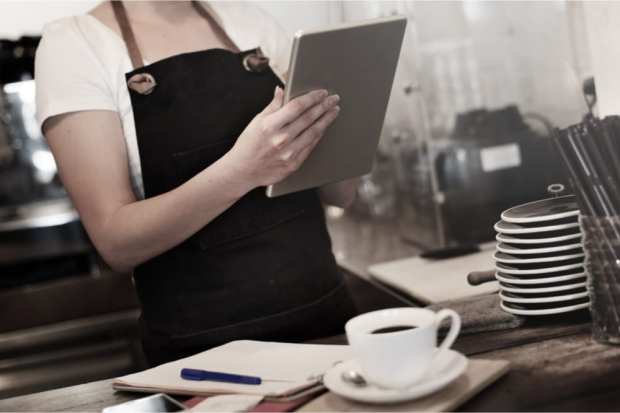Turning The Phone Into Restaurants’ Digital On-Ramp

When asked to quickly list the absolutely necessary pieces of equipment one finds in a restaurant, most people will tick off the usual suspects — an oven, a stove, a microwave oven, etc. The more technologically or health-minded among us might even note things like tablet-based POS systems or an HVAC system with disinfecting UV light built in to attack COVID-19.
But what almost no one will say restaurants need is a telephone. After all, in the era of digital, we can imagine many of our readers struggling to recall when they last rang up a restaurant to place an order or ask a question.
But where one lives can have a distorting effect on perceptions — something easily observable when it comes to restaurants and their relationships with their phones, Bensen AI CEO and Co-Founder David Xiao told Karen Webster in a recent conversation. Xiao said the majority of U.S. restaurants still get about 50 percent of their sales via the phone as many customers continue to dial in to make orders.
That’s a figure Webster said she found hard to believe, but Xiao said that’s because she does most of her dining Boston — where phones’ prominence is a lot lower and digital channels are far more strongly developed. Head an hour up the road to some of Bensen AI’s partners within New Hampshire, and the story is very, very different.
“We’re working with some restaurants up there — including some franchisees and major chains — that had not heard of DoorDash before last year,” Xiao said. “These are just very different markets, and the general awareness of what is available both from the consumer point of view and from the restaurant-owner point of view varies greatly across the country.”
He said Bensen AI’s experience in the sector is instructive. The company started off in voice technology, particularly in the context of making food ordering via voice assistants like Alexa or Google Assistant. But Xiao said that as the firm studied the industry more closely (especially this year), the team began asking itself how it could be a better and more helpful resource to the industry.
Bensen AI turned its attention to the phone — and automating it to become a digital on-ramp for restaurants.
Redirecting Callers To Digital Channels
Xiao said that restaurants have run into personnel problems during the pandemic that fall into two large buckets.
The first is that many have found it difficult to bring furloughed workers back. Xaio said this problem was particularly acute when the U.S. government offered unemployed workers an extra $600 a week in enhanced jobless benefits. Many people could choose to stay out of the workforce without taking an economic hit.
However, the second problem is more acute — restaurant revenue is down sharply and is expected to remain depressed for quite some time. Restaurateurs don’t have big budgets for staff right now, and they really can’t afford to have someone tied up on the phone during most of a shift.
“They need to calculate every hire very cautiously to make sure that it’s worth bringing on that person given the amount of business that [restaurants] have,” Xiao said. “Answering the phone is one of the least revenue-generating, lowest-ROI uses for an employee. So, if [restaurants] can get that to be automated to whatever extent, that is a win for them.”
Say Hello To ‘Greet’
That’s what Bensen AI set out to develop. The firm’s new Greet system can become a restaurant’s automated receptionist.
Greet conveys the necessary information upfront, such operating hours or any important issues like using a drive-through or curbside pick-up options. From there, an automated system can guide potential customers to the restaurant’s digital channels via a text message that provides links to the digital experience.
“It is a better way to get the customer what they are looking for in a way that provides a great experience in terms of customer service,” Xiao said. “[Greet] diverts them to the kinds of digital channels that the restaurant is able to handle much more efficiently than having an employee in the store answer the phone.”
Greet can reduce the labor load coming off the phone by 50 percent or more, allowing eateries to reallocate labor to more efficient usage. And Xaio added that the service was designed for a rapid rollout.
“When it comes to onboarding times in this vertical, we are normally talking about months,” Xiao said. “[But] in this current environment, that’s really not feasible any more. Restaurants are trying to survive week to week and even day to day. They aren’t thinking that far out ahead. We really focused on what we can do to scale down the onboarding time and make this operational in a matter of days.”
What’s Next
Xiao said restaurants aren’t the only vertical where the phone is the unsung hero of the revenue-generation department.
So, Bensen AI is planning to soon release a new version of Greet that’s suitable for businesses of any kind that do lots of work over the phone.
“We think about people making appointments at doctor’s offices or making appointments at local salons or calling a plumber or calling a chiropractor,” Xiao said. “All of these are businesses are experiencing the same kinds of labor pressures that we see across the economy. We’re excited about diving into those verticals as well and offering Greet to them.”
After all, Xiao said we have a way to go before the economy can really fully recover. For instance, few consumers will sit indoors and dine surrounded by strangers until there’s a COVID-19 vaccine.
Until that happens, businesses will need solutions that will help them survive — and set them up to thrive down the line when this is all over.
